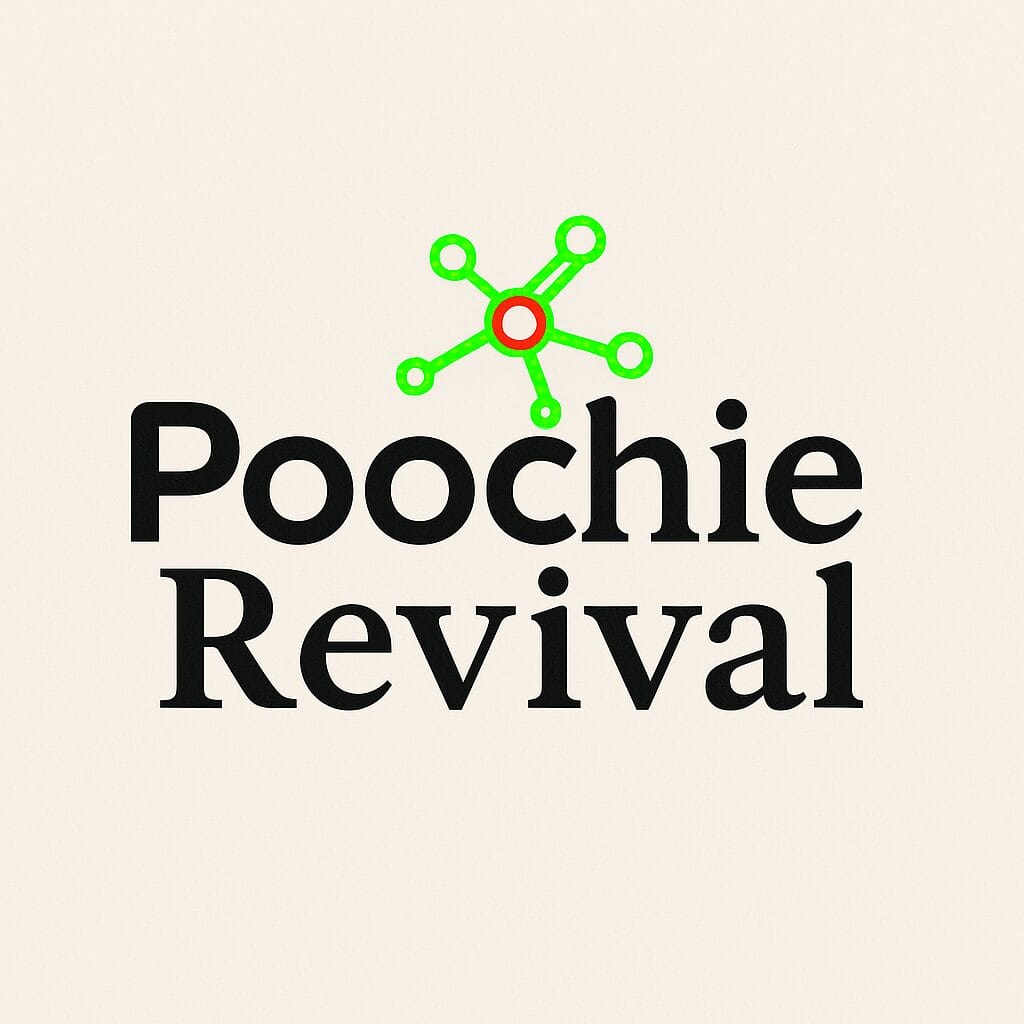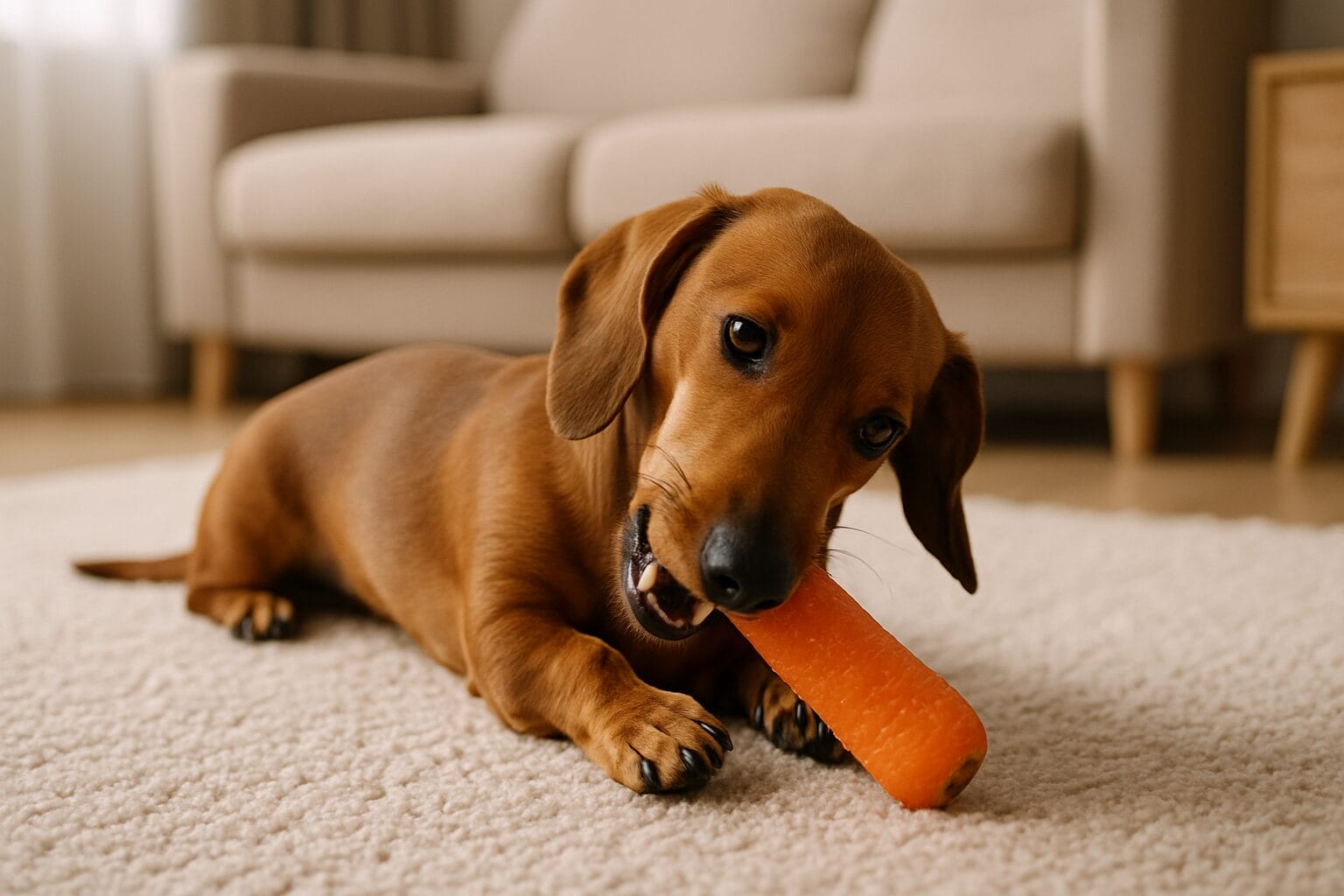Beta-carotene is one of the carotenoids, which are practically a minor source of antioxidants for dogs from a typical canine diet.
Often, the orange color of a plant part comes from beta-carotene, as in carrots. A good generalization is that the bright colors of plants always come from carotenoids, at least when it comes to edible plants.
However, a dog can convert beta-carotene into vitamin A in its liver, but with poor efficiency. If one wanted to convert a dog to a vegan diet, an amount of carrots exceeding the dog’s eating capacity would be needed to cover the vitamin A requirement.
Apart from its antioxidant properties, the health benefits claimed in the supplement market and in various nutrition articles for beta-carotene are actually the normal functions of vitamin A in the body.
Synthetic beta-carotene is used as a preservative and as a food coloring.
Dog’s Beta-carotene Requirement
Beta-carotene is not a vitamin-like nutrient for dogs, and there is no recommended intake for it. Carotenoids are not vitamins for humans either, even though their intake is considered healthy. But if the entire intake of vitamin A is based on carotenoids, like beta-carotene, then it becomes a vitamin. In that case, beta-carotene is not needed for its own sake, but because it can be converted into retinol within certain limits.
If we exclude herbivores, who do not have any intake of animal-derived vitamin A, then the conversion of (beta)carotenoids to retinol in the liver is an evolutionary backup system for situations where absolutely necessary retinol is not available.
This capability is present in all omnivores and in a large portion of carnivores. The fact that felines cannot make this conversion effectively due to an enzyme deficiency, meaning they rely on assumed sufficient retinol, does not make cats more carnivorous. It just makes them more specialized eaters with a narrower diet.
In fact, most beliefs about cats being pure carnivores are not true. Cats convert LA to arachidonic acid like dogs. Cats also convert beta-carotene like dogs. But cats have a lower vitamin A requirement than dogs, according to the NRC — this is likely due to their lower energy consumption.
Therefore, a dog does not inherently need beta-carotene, although adding antioxidants might be reasonable. In that case, it would be better to use more effective vitamin E, which has other functions in the body.
Utilization of Beta-carotene
The conversion of beta-carotene to vitamin A is minimal in micrograms. Calculatively, 1 µg of vitamin A corresponds to 12 µg of beta-carotene.
This would mean that if a 20 kg dog needs 600 µg per day, according to Fineli’s values, about 3 grams of beef liver is sufficient, whereas nearly 80 grams of carrots would be needed per day, assuming that the entire beta-carotene content of the carrot could be digested, absorbed, and converted completely to retinol.
A more realistic amount, considering the digestibility of carrots or cooking loss, would be closer to half a kilo per day — at which point such a large amount of carrots would disturb intestinal function so much that digestibility would actually decrease further.
If you give a dog beta-carotene, it should be given every day, like antioxidants and many other nutrients in general. The peak plasma level dependent on the dose is reached in six hours, after which the concentration decreases rapidly with a half-life of 3 – 4 hours1. These times apply to beta-carotene supplements, not foods containing beta-carotene. This is something to keep in mind when considering digestion duration. Some nutrients are absorbed faster than others, which has always been one reason to use supplements.
Species differences are significant. In humans, the peak value is reached in 24 – 48 hours2 and in cats in 12 hours3.
There is also a clear difference in the increase in plasma beta-carotene levels between carnivores and ruminants. When a dog is given a large dose of beta-carotene, 16 mg/kgBW, the plasma concentration is only one-tenth of what a calf reaches with a dose of 0.44 mg/kgBW4 or what a cat reaches with a dose of 1.5 – 3 mg/kgBW3.
A slight digression from the dog topic. A common claim is that cats cannot convert beta-carotene to vitamin A due to a lack of enzyme activity. This claim is not entirely accurate. When cats, which had no detectable carotenoids in their blood tests, were given 5 or 10 mg/kgBW of beta-carotene, the plasma retinol levels increased significantly within 16 hours5. The question is mainly whether the liver’s ability to convert beta-carotene is sufficient to meet a cat’s vitamin A needs, but the same doubt applies to dogs as well.
Often, those who consider natural feeding as their ideology use the assumption of what wolves and wild canids would eat in nature as a justification for various food choices. If we disregard BARF, which has no connection to wild feeding habits, naturalness usually refers to a variation of the prey model.
It is used as a justification specifically for giving plant foods, such as salads. Prey animals get carotenoids from their species-typical diet, but still, wild wolves do not have carotenoids in their plasma6. This partly debunks the myth of wolves eating the stomach and intestines of prey animals.
Beta-carotene Deficiency in Dogs
Since dogs have no nutritional need for beta-carotenes, they cannot develop any deficiency.
Of course, if a dog is switched to a strongly vegan diet and the food lacks beta-carotene or other carotenoids, or they are obtained in too small amounts, the dog will develop a vitamin A deficiency. However, this does not mean a beta-carotene deficiency, but specifically a vitamin A deficiency.
A complete lack of vitamin E causes, among other things, sterility and skin problems, but beta-carotene cannot replace vitamin E just because both are also antioxidants. They are two completely different compounds. Mentioning this self-evident fact may seem strange, but I have encountered several situations where an owner gives their dog beta-carotene — in salads or as a supplement — and justifies it with the functionalities of vitamin E.
Beta-carotene Overdose
A dog can be given an overdose of beta-carotene, but it is not known what dose per kilogram would be too much. An overdose is entirely individual for each dog. Practically, an overdose is harmless, but it is also known that antioxidants can become pro-oxidants when consumed in large quantities. In human smokers, synthetic beta-carotene has increased mortality, while natural beta-carotene decreased it. The reason may lie in the antioxidant turning into a pro-oxidant.
More accurately, the question of beta-carotene overdose means considering whether the food providing beta-carotene or other carotenoids causes digestive problems. One example is the connection between the sugars in carrots or the poor digestibility of sauerkraut and canine yeast.
Beta-carotene may color stools, secretions such as tears, and even the coat a more reddish or darker shade. This is not a permanent change. It has been suggested that some of the staining of dogs’ tears and mouth corners might be due to beta-carotene used as a food coloring, rather than the historically blamed copper. The fact that similar staining is found with meat-based raw feeding contradicts this assumption. The reason likely lies in a broader effect on the dog’s body’s enzymes.
Health Effects of Beta-carotene
Health effects must be weighed through the functioning of antioxidants and how different antioxidants work in metabolism, and in that context, beta-carotene is not useless, even though it is not essential.
Beta-carotene is often mentioned as a precursor to vitamin A, but that is not entirely accurate. Beta-carotene can be converted to vitamin A, but beta-carotene is its own compound, and its primary role in a dog’s metabolism is not necessarily to become retinol. It is just one possibility.
Beta-carotene acts differently and, to some extent, even more effectively as an antioxidant than retinol.
Beta-carotene functions in the immune system, but how significantly is quite unclear. There is even less information regarding dogs. Chew et al. (20007) gave 4 – 5 month-old female beagle puppies beta-carotene mixed with food for eight weeks in doses of 2, 20 (2.5 mg/kgBW), and 50 mg (6 mg/kgBW) per day and investigated what happened to various markers of immune response, such as leukocytes, interleukin-2, and immunoglobulins or antibodies igG and igM.
The food used was some commercial 26/16 dry food manufactured by Iams. The puppies were fed twice a day, and the daily portion was 200 grams — this is a slightly low portion for puppies weighing about 8 kg, but in a 2×2 meter living pen in a constant temperature, not much energy is consumed either.
Beta-carotene slightly strengthened the humoral (or acquired) immune response at doses of 20 and 50 mg per day, compared to dogs that did not receive beta-carotene. IL-2 and igM did not react, but igG levels increased.
The puppies were vaccinated, and the immune response was monitored, mainly through T-cells (“delayed-type hypersensitivity response”), and it was slightly stronger in the puppies that responded to beta-carotene — whether this has any significance for the strength of immunity provided by the vaccine or whether it just describes the function of beta-carotene on the immunity side, I do not know; it is beyond my expertise.
Interestingly, out of 28 puppies, four had plasma beta-carotene levels that rose significantly less than in others. They were excluded from the study, and the reason was not explored in this study. But it means that 14% of the studied puppies either did not absorb beta-carotene or it did not transfer to the plasma. According to the study, these dogs also had weaker immunity.
Chew et al. noted in relation to this that it should be remembered that the same administered amount does not work the same way in all dogs. This is quite self-evident, and I am more interested in why beta-carotene was not absorbed or used. Clarifying this might actually reveal the underlying cause of certain health problems in dogs.
There are certain differences between animal species. According to Chew et al.’s text, in mice, beta-carotene increased the number of Th-cells, which increased IL-2 production, but in dogs, IL-2 did not rise. In cattle, beta-carotene increased the number of mitogen-activated lymphocytes, but not similarly in dogs.
An interesting piece of information from a feeding and nutrition perspective was that the amount of beta-carotene given in the study did not affect plasma retinol. It did not, therefore, convert to vitamin A.
In general, beta-carotene studies focus around Chew and his research group. The conclusions are always similar: beta-carotene functions in immune response. What remains unanswered is whether the use of beta-carotene is more justified than that of vitamin E, or whether they can even be compared side by side.
Beta-carotene Intake from Food
It should be remembered that studies have always used beta-carotene as a supplement. No study has used food itself as the subject of investigation to determine if eating carrots does anything beneficial.
In a typical American diet (I do not know what that means), humans get about half of their required vitamin A through carotenoids. In dogs (and cats), however, vitamin A should always be obtained from animal sources, which practically means liver.
However, dogs can also get carotenoids from a meat-based diet. This is because the animals used for food get carotenoids from their own diet, and for them, carotenoids cover 100% of the vitamin A requirement. The stored amounts, which appear as nutritional values, are notably low, indicating that beta-carotenes are practically stored only as retinol.
According to Fineli, beef liver contains 864 µg/100 g of carotenoids. When the amounts of beta-carotene used in studies have been several milligrams per kilogram, the less than a milligram provided by the liver in a portion that is not fed is completely insignificant. In that case, beta-carotenes should be sought from berries, colorful vegetables, or carrots, whereupon we encounter a digestibility problem.
Carrots can be cooked, improving their digestibility — at least in terms of sugars. When boiled, the loss of water-soluble vitamins is about 40 – 50%, but when raw carrots contain 11.3 mg/100 g of carotenoids, even without considering cooking loss, to achieve 10 mg/kgBW of beta-carotene, 100 g/kgBW of carrots should be given. This would mean two kilos of carrots for a 20 kg dog. Every day.
- Boon P. Chew, Jean Soon Park, Brian C. Weng, Teri S. Wong, Michael G. Hayek, Gregory A. Reinhart. Dietary β-Carotene Is Taken up by Blood Plasma and Leukocytes in Dogs. The Journal of Nutrition, Volume 130, Issue 7, July 2000, Pages 1788–1791.[↩]
- Brown, E. D., Micozzi, M. S., Craft, N. E., Bieri, J. G., Beecher, G., Edwards, B. K., Rose, A., Taylor, P. R. & Smith, J. C., Jr (1989) Plasma carotenoids in normal men after a single ingestion of vegetables or purified β-carotene. Am. J. Clin. Nutr.49:1258–1265.[↩]
- Chew, B. P., Weng, B. C., Park, J. S., Wong, T. S., Combs, R. S., Hayek, M. G. & Reinhart, G. A. (1997) Uptake of β-carotene by blood plasma and lymphocytes in cats. FASEB J11:A447 (abs.).[↩][↩]
- Poor, C. L., Bierer, T. L., Merchen, N. R., Fahey, G. C., Murphy, M., Jr & Erdman, J. W. (1992) Evaluation of the preruminant calf as a model for the study of human carotenoid metabolism. J. Nutr.122:262–268.[↩]
- A.S. Green et al., 2011. Domestic cats convert [2H8]-β-carotene to [2H4]-retinol following a single oral dose. JAPAN online July 2011.[↩]
- Slifka, K., Bowen, P. E., Stacewicz-Sapuntzakis, M. & Crissey, S. D. (1999) A survey of serum and dietary carotenoids in captive wild animals. J. Nutr.129:380–390[↩]
- B P Chew, J S Park, T S Wong, H W Kim, B B Weng, K M Byrne, M G Hayek, G A Reinhart. Dietary beta-carotene stimulates cell-mediated and humoral immune response in dogs. J Nutr. 2000 Aug;130(8):1910-3.[↩]




